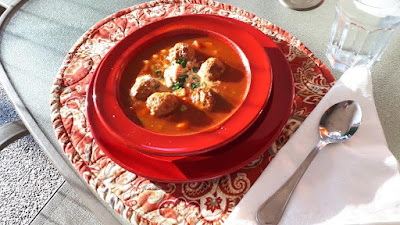I can’t imagine a more delicious salad to serve while Summer’s still with us! It’s light and refreshing and a dinner party winner, even among beet haters.
This is a muscular salad - not some genteel tea-party goodie. You don’t fool around with beets! And so, I prefer to use thicker, brawny slices of peeled, seeded cukes rather than the dainty, seedless English cucumbers I normally suggest.
About that dressing: I wouldn’t keep it more than two days. It seems to thin out and lose its flavor. Use the rest on a tossed salad or in coleslaw you plan to eat in a single sitting. Enough! Here’s what you've been waiting for!
Beet and Cucumber Summer Salad:
To Prepare the Salad:
4-to-6 medium-to-large beets, rinsed, peeled, and chunked into (approximately) 1 in. (1.5 cm)-to-1-1/2 in. (1.27 cm) pieces (see Note: How to Cook Beets)
1 medium red onion, sliced thin, with the slices separated as rings and halved or quartered
1 medium-to-large seeded cucumber, peeled and cut into 3/8 in. (0.95 cm) slices
Salt and pepper, to taste
Set aside a few slices of prepared onion and cucumber before proceeding. To work bowl, add prepared beets, onion, and cucumber, minus the onion and cucumber set aside. Cover and refrigerate all while assembling dressing.
To Prepare the Dressing:
1/2 c. (125 mL) sour cream (full fat sour cream holds up better than its anemic cousin)
1/4 c. (60 mL) mayonnaise (ditto)
2 tbsp. (30 mL) red wine vinegar
1 tbsp. (15 mL) Dijon mustard
1 tsp. (5 mL) hot horseradish (don’t wimp out on me, now!)
2 tbsp. (30 mL) dried dill weed
2 tsp. (10 mL) granulated sugar
Additional salt and pepper, to taste
To small work bowl or covered jar, add dressing ingredients, stirring or shaking until well combined. Don’t be tempted to drown the beets, cukes, and onions in dressing: Pour some and toss lightly; pour a little more and toss lightly until it looks just right, continuing to keep reserved ingredients aside. Cover and refrigerate 3 or 4 hr. before serving, so flavors can blend.
Transfer to serving bowl. Give this salad one final, light toss before taking it to the table. Poke reserved slivers of red onion and a few halved cucumber slices here and there as décor, allowing the reserved red onion and cucumbers to be visible after the salad’s been tossed.
 |
| Beet and Cucumber Summer Salad. |
Note: How to Cook Beets: Is there an official method? I don’t know, but this is what I do. Slice away each beet’s roots and tips, exposing a sliver of skin. Do not slice beets any further unless they’re the monster that ate your neighbor. In that event, cut them in half and hope for the best.
In a pot, slip beets into enough boiling, salted water to entirely cover beets. I sometimes add a splash of white vinegar and say a prayer that this will help them retain their bright red color.
Reduce heat to low boil, checking every 10 minutes (give or take) to ensure water remains at the boil. Check that beets are ready by piercing them with sharp paring knife after 30-to-45 min. Fresh beets will cook more quickly than old, hard beets, which take about an hour to cook.
Remove beets from pot with a slotted spoon, saving the boiled water for now. Rinse beets with cool water just until they’re tolerable to pick up (I wear disposable, non-latex latex gloves for this job). The skins of fully cooked beets should slide right off when they’re done.
If not, you’ll have a fight on your hands, paring away the skin and destroying the perfect appearance of a smooth, shiny beet. If you’d rather not do that, bring the water in your pot to the boil again, returning the stubborn beets to the pot to show them who’s boss.
If that doesn’t work either, compost the old beets in favor of younger, prettier, more cooperative ones. Alas! This is the way the world works.
Further Note: You may also want to try this Chilled Beet Salad: https://nicoleparton.blogspot.com/search?q=chilled+beet+salad
















